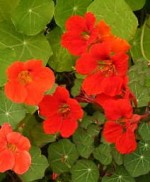 There are few flowers that can light up a their surroundings like nasturtiums can. Their intensely colored flowers in red, yellow and orange add zip to any garden border and can serve as an eye catching garnish in salads, sandwiches and punch. If you like interesting leaves, nasturtium leaves are sure to please with their peltate (shield-like) shape and central petiole. All parts of the plant are edible and have a peppery taste but the flowers are the most commonly used and the green seed pods can be cured in vinegar and used instead of capers. Nasturtiums are easy to grow from seed sown directly in the garden when the soil warms. They will bloom all summer and fall until frost in cool climates but decline when night time temperatures are consistently over 70 degrees. Some varieties are low and compact, while others are vine-like and will climb trellises. All do well in full sun and can be used in containers, window boxes, and hanging baskets. Some sources report that nasturtiums repel whiteflies, various cabbage pests, aphids, and squash bugs but their effectiveness is disputed.
There are few flowers that can light up a their surroundings like nasturtiums can. Their intensely colored flowers in red, yellow and orange add zip to any garden border and can serve as an eye catching garnish in salads, sandwiches and punch. If you like interesting leaves, nasturtium leaves are sure to please with their peltate (shield-like) shape and central petiole. All parts of the plant are edible and have a peppery taste but the flowers are the most commonly used and the green seed pods can be cured in vinegar and used instead of capers. Nasturtiums are easy to grow from seed sown directly in the garden when the soil warms. They will bloom all summer and fall until frost in cool climates but decline when night time temperatures are consistently over 70 degrees. Some varieties are low and compact, while others are vine-like and will climb trellises. All do well in full sun and can be used in containers, window boxes, and hanging baskets. Some sources report that nasturtiums repel whiteflies, various cabbage pests, aphids, and squash bugs but their effectiveness is disputed.
Type: Annual.
Bloom: Funnel shaped, 1- 2½” wide flowers are produced in vivid orange, yellow or red. Each flower has 5 petals that are fused at the base, and five sepals one of which has a long spur.
Foliage: Light green, alternate, smooth leaves are round or shield-shaped with a central, long petiole.
Size: 1’ H x 2’W (vines up to 6’ long).
Light: Full sun.
Soil: Average, well-drained; may be somewhat drought tolerant once established.
Care: Sow soaked or scarified (filed) seeds directly in the garden where they are to grow as they do not transplant well.
Pests and Diseases: Susceptible to aphids, white flies, cabbage worms, leafhoppers, spider mites, and mosaic virus.
Propagation: Seed; may reseed.
